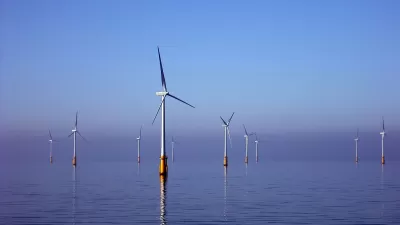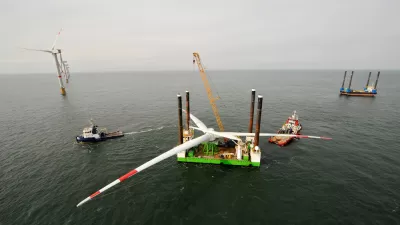Visitors from small islands off the coast of Maine traveled to Samsø, a larger island off the coast of Denmark, to learn how to emulate its transformation into a model of renewable energy.
Samsø, a 44-square-mile island off the Danish coast of 4,100 inhabitants largely devoted to agriculture, has won international acclaim since 1997 when it won "a government-sponsored contest to create a model community for renewable energy," writes New York Times business reporter, Diane Cardwell. Eight years later, "the island reached green energy independence."
Inspiring the visitors from Maine, including those from the one-square mile island of Monhegan, population 65 that "swells to hundreds of residents and thousands of tourists in the summer," may have been more economic as opposed to environmental goals, in particular its "dependence on expensive, dirty fuels for heating and electricity."
Even with the recent fall in oil prices, Monhegan residents pay among the highest power rates in the nation — almost six times the national average — and the electric company, locally owned and operated, struggles to keep the lights on.
Unlike the much larger island of Samsø, the Maine islands are not connected to the mainland via power cables, though now the cable from Samsø works both ways as it sells its excess renewable power. The Maine islands must be truly self-sufficient for electricity and heating.
The Maine visitors, including students from the College of the Atlantic in Bar Harbor, were attending the Samsø Energy Academy. "If all went well, each islander would go home with a team of students dedicated to solving an energy problem using ideas borrowed from Samsø," writes Cardwell.
According to the Rocky Mountain Institute (via Clean Technica), Samsø is 100 percent wind-powered from "eleven onshore wind turbines (that) provide 11 megawatts of power [PDF]." Heat is supplied from geothermal, biomass, and solar power sources.
And 10 offshore wind turbines produce 23 megawatts, enough to compensate for the carbon dioxide emissions generated by the island’s transport sector. This was all accomplished within eight years, two years ahead of schedule.
"There are not yet any full-scale offshore wind farms in the United States — projects like Cape Wind near Nantucket have been delayed by legal and financial challenges — so the Mainers were eager for a rare chance to see one up close," writes Cardwell.
FULL STORY: Green-Energy Inspiration Off the Coast of Denmark

Alabama: Trump Terminates Settlements for Black Communities Harmed By Raw Sewage
Trump deemed the landmark civil rights agreement “illegal DEI and environmental justice policy.”

Study: Maui’s Plan to Convert Vacation Rentals to Long-Term Housing Could Cause Nearly $1 Billion Economic Loss
The plan would reduce visitor accommodation by 25% resulting in 1,900 jobs lost.

Why Should We Subsidize Public Transportation?
Many public transit agencies face financial stress due to rising costs, declining fare revenue, and declining subsidies. Transit advocates must provide a strong business case for increasing public transit funding.

Paris Bike Boom Leads to Steep Drop in Air Pollution
The French city’s air quality has improved dramatically in the past 20 years, coinciding with a growth in cycling.

Why Housing Costs More to Build in California Than in Texas
Hard costs like labor and materials combined with ‘soft’ costs such as permitting make building in the San Francisco Bay Area almost three times as costly as in Texas cities.

San Diego County Sees a Rise in Urban Coyotes
San Diego County experiences a rise in urban coyotes, as sightings become prevalent throughout its urban neighbourhoods and surrounding areas.
Urban Design for Planners 1: Software Tools
This six-course series explores essential urban design concepts using open source software and equips planners with the tools they need to participate fully in the urban design process.
Planning for Universal Design
Learn the tools for implementing Universal Design in planning regulations.
Smith Gee Studio
Alamo Area Metropolitan Planning Organization
City of Santa Clarita
Institute for Housing and Urban Development Studies (IHS)
City of Grandview
Harvard GSD Executive Education
Toledo-Lucas County Plan Commissions
Salt Lake City
NYU Wagner Graduate School of Public Service





























